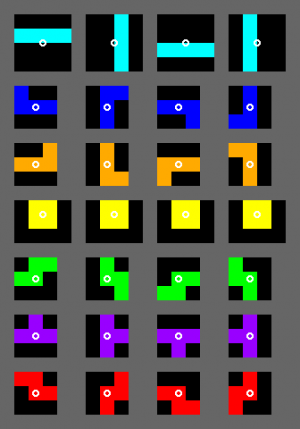From Hard Drop Tetris Wiki
|
Tetris DX | |
|---|---|
| [[File:{{{boxart}}}|175px]] | |
| Developer(s) | Nintendo |
| Publisher(s) | Nintendo |
| Release Date(s) | 21, Oct 1998 (Japan) 31, Oct 1998 (USA) 1, Jul 1999 (Europe) |
| Platform(s) | Game Boy Color |
|
Gameplay Info | |
| Next pieces | 1 |
| Playfield dimensions | 10x18 |
| Hold piece | No |
| Hard drop | No |
| Rotation system | {{{system}}} |
| Has 180 rotation | {{{180}}} |
| Adjustable tuning | {{{tuning}}} |
| Garbage attack type | {{{garbage}}} |
| Garbage blocking type | {{{blocking}}} |
| Website | {{{website}}} |
 |

|
Not to be confused with Tetris Deluxe, a game released for western mobile phones.
Tetris DX was a Game Boy Color game as an enhancement of Nintendo's original Game Boy Tetris, with two added gameplay modes (Ultra, lasting 3 minutes; and Vs. CPU, a match against the computer), a profile/save feature, and color graphics on Game Boy Color and above. In addition, the game's rotation system had a glitch which lets a player move any tetromino except O upward by holding the direction against a wall while rotating in the opposite direction.
Rotation system

The rotation system is an early version of what would become SRS. Tetrominoes of width 3 rotate as if in a bounding box, though L, J, and T start flat side up.
- The following description is based on a machine translation of a document written in Japanese into English. It may have been misunderstood. You can help TC wiki by confirming this behavior.
TDX first tries rotation about the center of the bounding box (the white circle in the SRS diagram), then rotation about the bottom of the bounding box (the space below the white circle in the third column).
See also
Tetris and other puzzle games published by Nintendo {{}}
Console: Tetris (NES, Nintendo) | Tetris 2 | Tetris & Dr. Mario | 3D Tetris | The New Tetris | Tetris 99
Handheld: Tetris (Game Boy) | Tetris Blast | Tetris DX | Pokémon Tetris | Tetris DS | Tetris Axis
Topics: Nintendo Rotation System | Nintendo Wi-Fi Connection